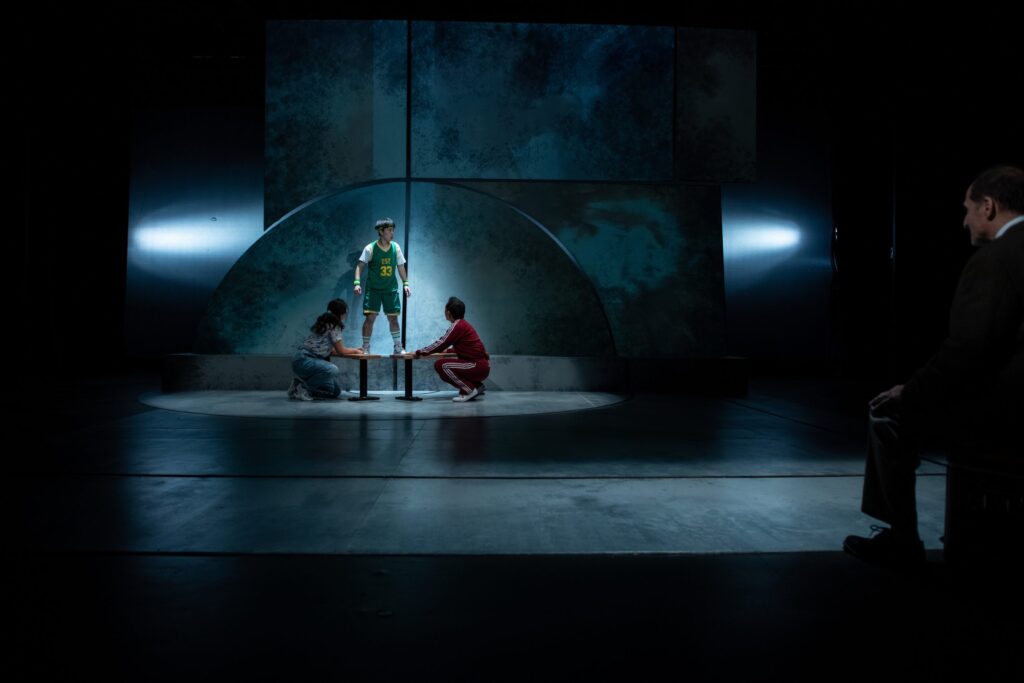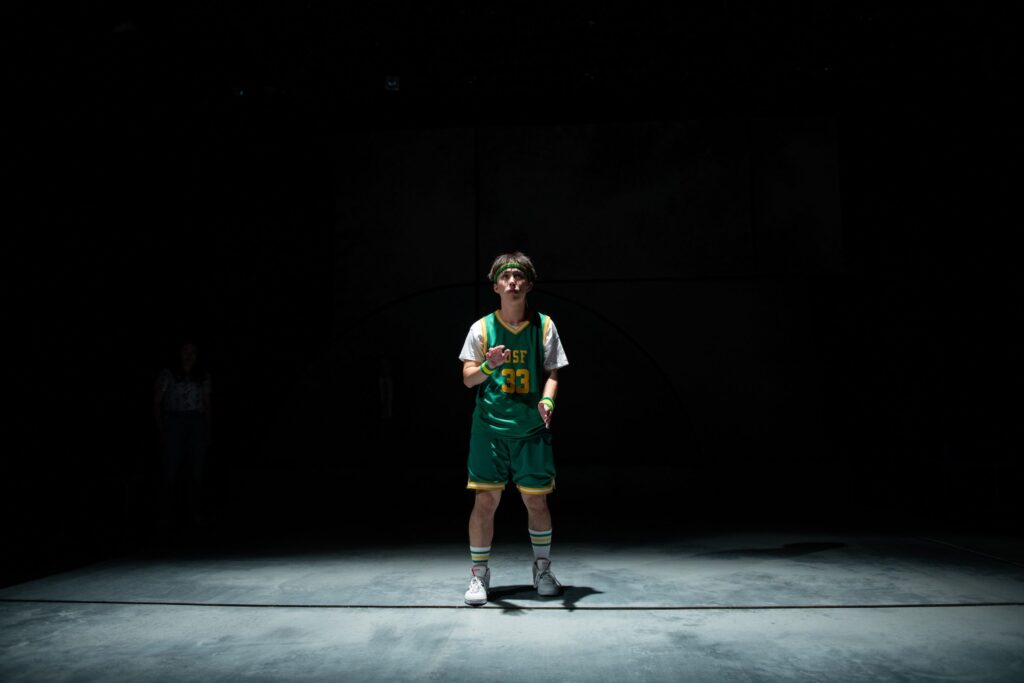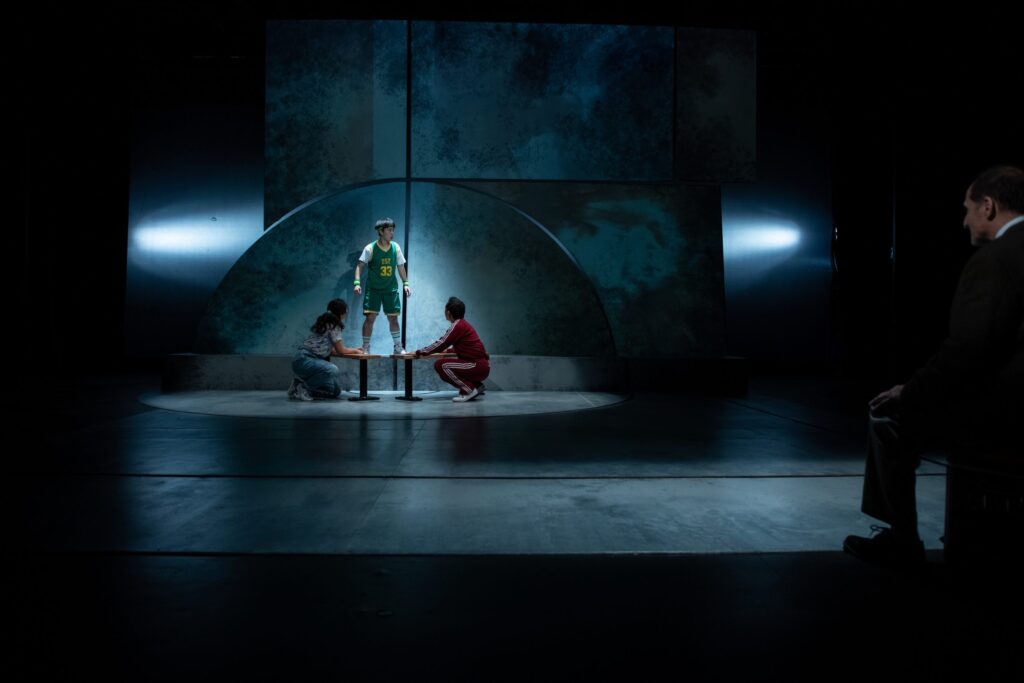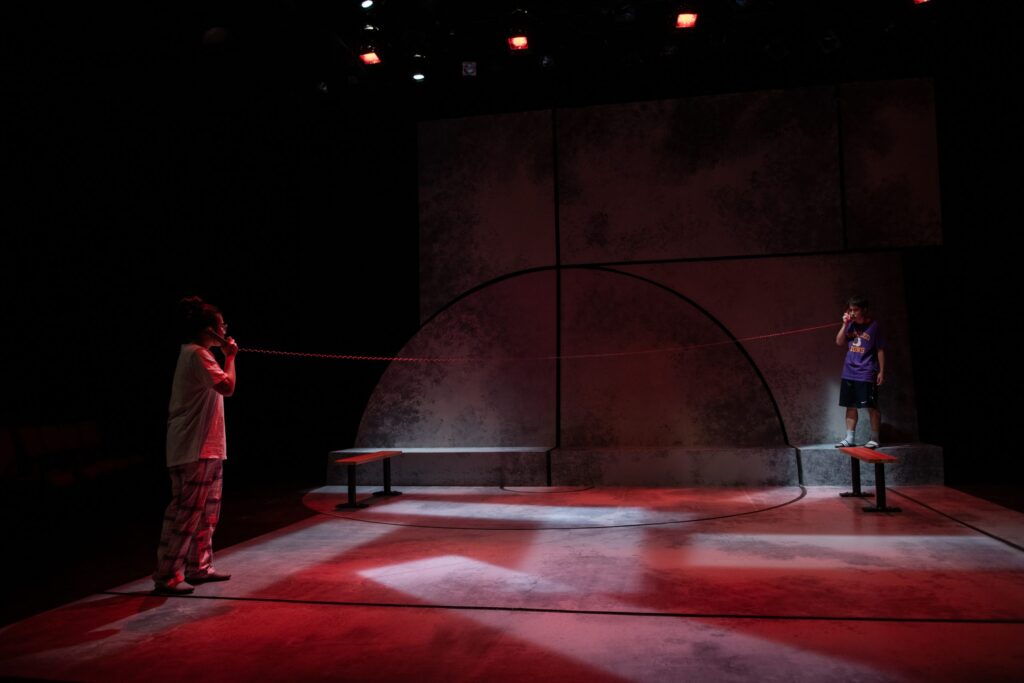
‘The Great Leap’ – Written by Lauren Yee. Directed by Natsu Onoda Power. Scenic Design by Anita Stewart. Costume Design by Nicole Wee. Lighting Design by Alberto Segarra. Sound Design by Kathy Ruvuna. Projection Design by Dylan Uremovich. Presented by Portland Stage at 25A Forest Ave, Portland, ME through October 2nd (closed).
by Linda Chin
Always hungry for new narratives that build community and cultural understanding, and still marveling from powerful productions of award-winning playwright Lauren Yee’s Cambodian Rock Band at Lowell’s Merrimack Rep and NYC’s Signature Theatre a few years before, I hightailed it from Boston to Portland Stage for The Great Leap. These plays helped Yee garner the double distinction of having multiple works on American Theater’s list of Top 10 Most Produced Plays, and of being one of the nation’s Top 20 Most Produced Playwrights (second to Lauren Gunderson) in 2019-20.
In telling these stories, Yee zooms in on snapshots of extraordinary times in modern Asian history and on grainy photographs of ordinary people whose identities are unknown. In Cambodian Rock Band, it’s an image of survivors of the Phnom Penh S-21 prison where the Khmer Rouge murdered thousands of people between 1975 and 1979. In The Great Leap it’s the photo of the tanks rolling into Tiananmen Square (and a faceless man blocking their path) during the protests in 1989, and a publicity photo of a U.S. coach who coached a Chinese basketball team at the height of the Cultural Revolution in 1971 shaking hands with his translator. Both plays also involve time-toggling, with young Asian American protagonists traveling thousands of miles to their parents’ homeland, prompted by their desire to explore their dual identities, connect the dots in their family history, and make sense of the mysteries in the old photographs.

The Great Leap’s hero is 17-year old Chinese American Manford Lum (an earnest and riveting Ray Yamamoto), a high school senior who is struggling to figure out his future career path – or as urgently, his first steps on the long journey of grieving his mom’s recent passing. Born and raised in San Francisco’s Chinatown, his single mom gave him the “aspirational name” Manford (after the top Bay Area university) but purportedly didn’t push him to succeed. As he wistfully recollects with his college-educated, older “cousin” Connie (an empathetic and effervescent Eileen Doan), he and his mother hardly talked or knew each other; when she wasn’t working they spent hours at home watching Warrior games and she urged him repeatedly to practice his game, to “go outside.” Heeding her advice, he’s become a phenom on the street courts. He keeps up his skills by sinking 100 baskets every night before he goes to bed. But what are your future prospects of being a point guard on a U.S. college team if you’re an Asian American kid who’s only 5’7” tall?
Manford learns about an opportunity to answer this question from an article (and archival photograph) that he fortuitously finds in the local newspaper that ran his mother’s obituary. The U.S. coach, Saul (who visited China 18 years before and coaches the University of San Francisco team) has been invited to a “Friendship Game” by his old friend/former translator Wen Chang (who has coached Beijing’s top team for the past 18 years), which for the sake of career security they are both determined to win. (Veteran actors Jim Shankman and Norman Garcy Yap are perfectly cast as a Jewish and a Chinese man trying their best to be good coaches, partners, and fathers; their acting and accents are authentic, and they don’t lapse into stereotypes.) Unbeknownst to Connie or anyone else, Manford decides to take the leap and try out for the team.

Anita Stewart’s scenic design is spare but elegant. With round and straight tape lines marking a basketball court pattern on the floor and a Mondrian-like collage on the back wall, a long wooden bench at the rear and a hard cooler down front at the top of show, the stage comes alive when populated with evocative lighting, carefully curated projections of people, places, or propaganda (a poster with Chairman Mao’s bao-shaped face cheerfully promoting basketball for all a fabulous find/creation) and especially – the stunningly talented storytellers.
Natsu Onoda Power’s strong casting choices and taut but fluid direction make The Great Leap a winner. Individually, actors Eileen Doan, Jim Shankman, Ray Yamamoto, Norman Garcy Yap have strong stage presence, and in every permutation of scene partners deliver strong performances akin to a well-coached, well-oiled team of star athletes playing their best game. As in Yee’s Cambodian Rock Band (where the actors played instruments) the characters in The Great Leap are multi-layered and complex, and require actors with a full toolbox – strong physical acting skills, clear elocution, keen understanding of their characters’ speech patterns, emotional styles, and cultural context, and stamina.

The actors rely on only a small number of simple props in the production, including the aforementioned hard cooler that Saul sits on during “office” hours and the newspaper with his mom’s obituary and old photo of Saul and Wen Chang that Manford clings to, and the piece of paper on which Manford has written a speech to convince Saul to put him on the team. A pair of “retro” red handsets connected to opposite ends of a 20+ foot phone cord used in a long-distance call between Manford (in Beijing) and Connie (in SF) is a clever touch. The fact that the team can tell a basketball story, can create the nail-biting tension of the last few seconds of a tied game, without using a physical basketball is impressive as well. Lastly a pair of bags that Wen Chang hastily packs as he prepares to participate in the Tiananmen Square protests (instead of merely observing from the safety of his high-rise) adds to the play’s very poignant closing image.
To The Great Leap’s dual references – to Mao Zedong’s forward-thinking economic plan that changed the lives of millions, and that glorious moment when a basketball player begins his ascent to score one for the team, I’d like to add a third: In our changing world – with pressures mounting on theater companies to stabilize their finances, appeal to old and attract new audiences, and increase equity, diversity, inclusion and access – I am grateful to theater companies like Portland Stage for taking the leap and including new narratives like The Great Leap in their 2022-23 seasons; for increasing representation and giving audiences the opportunity to see people of color on and off-stage; for giving Asian Americans the thrill of being heroes of our own stories, and; for inspiring us all to not stand still.

